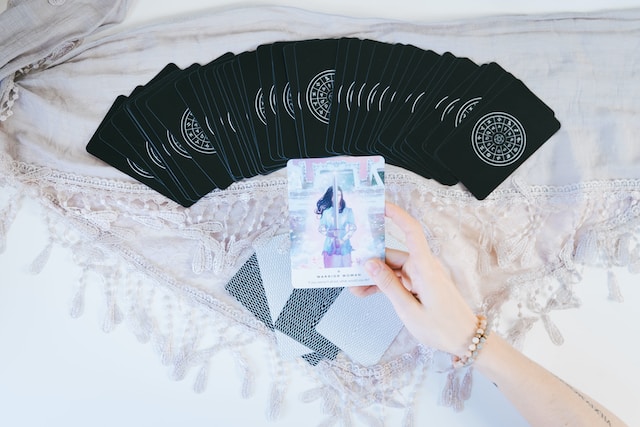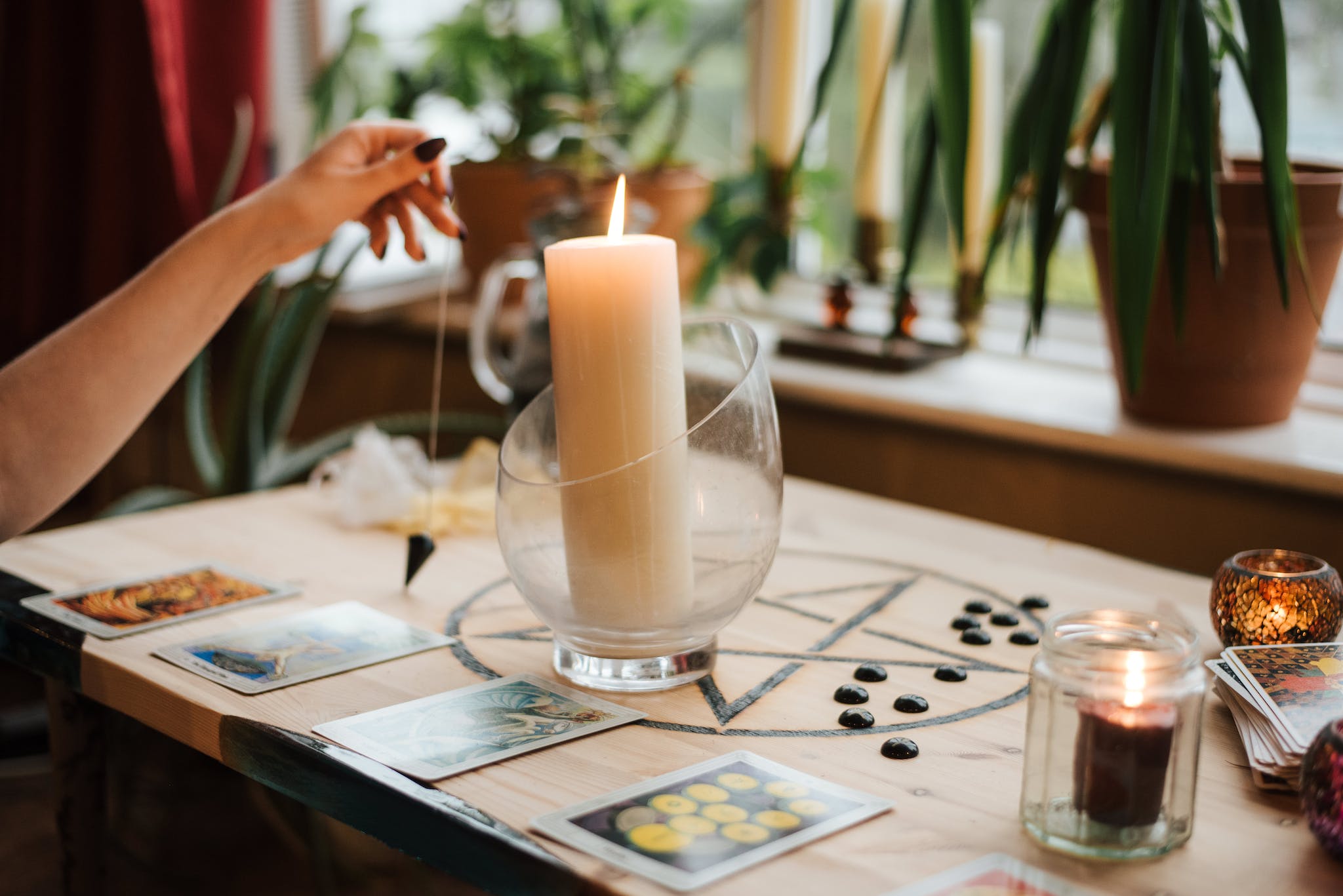Tarot For Healing And Self-Care: Using The Cards To Promote Emotional Well-Being
There are some affiliate links below, but they are all products I highly recommend. For more info, view my disclosure here.
We’ve all experienced moments of emotional turmoil, stress, or self-doubt. It’s natural to seek comfort and guidance during these times – whether it be through talking with friends, practicing mindfulness techniques, or engaging in self-care rituals.
One tool that you might not have considered for healing and self-care is tarot. While often associated with fortune-telling and divination, tarot can also be a powerful instrument for promoting emotional well-being and personal growth.
Don’t worry if you’re new to tarot or feel skeptical about its potential benefits; we’re here to explore how the cards can be used as a unique form of self-care that fosters introspection, self-awareness, and emotional healing.
By tapping into the symbolism and archetypes within the tarot deck, you’ll learn to access your own intuition and inner wisdom – ultimately empowering yourself to make more mindful decisions and better navigate life’s challenges.
So grab your favorite deck (or find one online) and let’s embark on a journey towards greater emotional well-being together!
An Introduction To Tarot And Its Symbols
When you think of tarot, what comes to mind? For many, it’s a mysterious tool shrouded in esoteric symbols and ancient wisdom. But at its core, tarot is a powerful tool for healing and self-care. By understanding the symbolism behind the cards and learning how to tap into their wisdom, we can use tarot to promote emotional well-being and personal growth.
Each card in a tarot deck carries a unique message, represented by intricate symbols and imagery. These symbols can be traced back through history to ancient spiritual traditions, where they were used as tools for profound self-discovery. Tarot cards serve as mirrors that reflect our deepest emotions, challenges, and aspirations. They can help us gain clarity about our inner selves while providing guidance on how to navigate life’s challenges.
To begin using tarot for healing and self-care, it’s essential to familiarize yourself with the basics of the deck. A standard tarot deck consists of 78 cards divided into two main groups: the Major Arcana and the Minor Arcana. The Major Arcana features 22 cards that represent significant life events or themes. The Minor Arcana comprises 56 cards divided into four suits – Cups (emotions), Wands (creativity), Swords (intellect), and Pentacles (material world) – which represent different aspects of daily life.
As you work with your tarot deck, you’ll notice that some of the cards may resonate with you more than others based on your current circumstances or emotional state. This is completely normal! Allow yourself to be drawn toward certain cards or symbols as part of your journey towards healing and self-understanding.
Remember that there are no right or wrong interpretations; each person’s experience with tarot is unique and personal. Embrace this opportunity for growth and transformation while using these ancient symbols as guides on your path towards emotional well-being.
Choosing The Right Deck For You
When it comes to choosing a tarot deck for your healing and self-care journey, it’s essential to find one that resonates with you on a personal level. There are countless decks available, each with its unique artwork and interpretation of the traditional tarot symbolism. Some decks may instantly draw you in, while others might not feel like the right fit. Remember, there’s no ‘one size fits all’ when it comes to tarot – what works for someone else might not work for you.
To begin your search for the perfect deck, spend some time browsing through various options and see which ones catch your eye. You can look at online stores or visit local metaphysical shops to get a feel for the different styles available. Look at the artwork and read about the creator’s intentions behind their designs. Sometimes, a particular theme or artistic style can make all the difference in how connected you feel to a deck.
Another factor to consider is whether you’re drawn more towards traditional or modern interpretations of tarot symbolism. Some people prefer sticking with classic imagery such as the Rider-Waite-Smith deck, while others find contemporary decks with updated themes more relatable. It’s also possible that you’ll be drawn to specific types of imagery based on your spiritual beliefs or personal interests.
Trust your intuition as you explore different decks; it will guide you towards the one that best suits your needs.
Once you’ve found a few potential options, take some time to meditate on which deck feels like the right choice for your healing journey. You may even want to sleep on it before making a final decision.
When selecting a tarot deck for self-care and emotional well-being, it’s crucial that it feels like an extension of yourself – an intimate tool that reflects your inner world and supports your growth process. So don’t rush this decision; give yourself space and time to discover the perfect companion for your transformative journey with tarot.
Techniques For Grounding And Centering
Have you ever felt scattered or overwhelmed by daily life? Grounding and centering techniques can help bring you back to a place of balance and peace. In this section, we will explore various methods that utilize tarot cards as a tool for grounding and centering, allowing you to connect with your inner self and find emotional stability.
One effective technique is to meditate with a tarot card that resonates with you. Choose a card that represents grounding, stability, or inner peace – such as the Four of Wands, the Star, or the Emperor.
Hold the card in your hands, close your eyes, and take several deep breaths. Focus on the imagery of the card and imagine its energy flowing through you, anchoring you to the present moment. Spend at least 5-10 minutes in this meditative state before slowly bringing yourself back to full awareness.
Another useful approach is creating a personal grounding ritual using tarot cards. Start by selecting three cards: one representing your physical body (such as Strength or The Empress), one for your emotions (like Cups cards), and one for your mental state (Swords or Pentacles).
Lay these cards out in front of you in this order – body, emotions, mind – and light a candle if desired. Take a moment to focus on each card’s energy individually while taking deep breaths. Then visualize their energies merging together into a single force that grounds and centers you.
Lastly, practicing daily mindfulness with tarot can be beneficial for maintaining emotional well-being. Draw one card each morning as part of your routine and spend some time contemplating its meaning. Carry this message throughout your day by keeping it at the forefront of your thoughts or even carrying an image of it with you as a visual reminder.
This practice will not only help keep you grounded but also provide insight into how different aspects of Tarot relate to your daily life experiences. By incorporating these grounding and centering techniques into your tarot practice, you’ll find yourself better equipped to handle the challenges that life can bring.
Whether meditating with a single card, creating a grounding ritual, or practicing daily mindfulness, tarot cards can offer powerful support for emotional healing and self-care. Remember to be patient with yourself and trust in the wisdom of the tarot as you embark on this journey of self-discovery and personal growth.
Interpreting Tarot Cards For Emotional Insight
Having explored various techniques for grounding and centering, it’s time to delve deeper into the world of tarot as a tool for emotional insight.
The process of interpreting tarot cards can be an incredibly powerful way to access your inner wisdom and gain clarity on your emotions. In this section, we will discuss how to approach tarot readings from a perspective of healing and self-care in order to promote emotional well-being.
When reading tarot cards with the intention of gaining emotional insight, it is important to remember that the cards are not meant to predict the future or provide definitive answers. Instead, they serve as a mirror reflecting your inner world and providing guidance based on your current emotional state.
Approach each reading with an open mind and heart, focusing on understanding yourself better rather than seeking external validation.
As you begin interpreting the cards in a spread, pay close attention to the images, symbols, colors, and overall energy of each card. These visual elements can offer valuable insights into your emotional landscape.
For example, a card depicting a calm ocean might represent peace and tranquility within yourself, while a card showing turbulent waters could signify unresolved emotions or conflicts that need addressing.
Allow yourself to connect intuitively with each card’s imagery; let your instincts guide you towards understanding their meanings in relation to your emotions.
To further enhance the healing power of tarot readings for emotional insight, consider incorporating additional self-care practices into your routine. This could include journaling about your interpretations and feelings after each reading or engaging in meditation or mindfulness exercises before or after readings.
By combining these practices with tarot readings focused on promoting emotional well-being, you can create a powerful synergy that supports deep personal growth and transformation over time.
Developing A Personalized Self-Care Tarot Ritual
When it comes to nurturing our emotional well-being, there’s no one-size-fits-all solution. Each of us has unique needs, preferences, and circumstances that shape our journey towards healing and self-care. With this in mind, developing a personalized tarot ritual can serve as an empowering tool to deepen your connection with yourself and foster a sense of inner harmony.
To begin crafting your self-care tarot ritual, start by setting aside time and space for regular practice. Consistency is key when working with the tarot to promote emotional well-being.
Determine how often you’d like to engage in your ritual – daily, weekly, or monthly – based on your personal needs and schedule. Create a sacred space where you feel comfortable and relaxed; this could be as simple as lighting a candle or setting up an altar with crystals, incense, or any other items that hold personal significance.
Next, consider the specific self-care goals you’d like to focus on during your tarot sessions. These may include fostering self-love, releasing negative thought patterns, cultivating gratitude, or seeking guidance through challenging emotions.
With these intentions in mind, choose a tarot spread that resonates with you and aligns with your objectives. For instance, you might opt for a three-card spread representing past influences, present circumstances, and future possibilities related to your goal. Remember that the tarot is meant to be flexible; feel free to adapt or create spreads that best serve your intentions.
As you engage in your personalized self-care tarot ritual regularly over time, take note of any insights gleaned from the cards and reflect on how they have impacted your emotional well-being.
Journaling about each session can help solidify these realizations and track progress towards achieving greater balance within yourself. By cultivating a deeper understanding of both the tarot’s wisdom and your own emotional landscape through this practice, you’ll be better equipped to nurture yourself holistically while navigating the complexities of daily life.
Exploring Tarot Spreads For Personal Growth
Have you ever felt stuck in a rut or in need of some guidance on your personal growth journey? Tarot spreads can be a powerful tool to help you gain insight into your own self-improvement process.
In this section, we’ll explore different tarot spreads specifically designed for personal growth and unlocking your true potential. These spreads can help you reflect on your past experiences, identify areas needing improvement, and set goals for the future.
One popular spread for personal growth is the ‘Mirror Spread.’ This layout consists of six cards that represent various aspects of your life: self-image, values, dreams and goals, obstacles, strengths and weaknesses, and the outcome. By reflecting on these areas, you can gain a deeper understanding of yourself and make meaningful changes. The Mirror Spread is especially useful when you’re feeling lost or disconnected from your authentic self.
Another insightful spread is the ‘Growth Spiral,’ which focuses on three main categories: mind, body, and spirit. To perform this spread, draw nine cards – three for each category – arranged in an upward spiral pattern. This layout helps you examine how well-balanced your life is in terms of mental health, physical well-being, and spiritual development. The Growth Spiral offers guidance on how to nurture all aspects of yourself for holistic personal growth.
As you delve deeper into using tarot spreads for personal growth, don’t be afraid to get creative with your own layouts or customize existing ones to suit your needs better. Remember that tarot cards are simply tools to help facilitate introspection; it’s up to you to take action based on the insights gained from them.
By regularly practicing these powerful spreads and engaging in honest self-reflection, you’ll be well on your way towards emotional well-being and becoming the best version of yourself possible.
Overcoming Challenges And Embracing Change With Tarot
As we continue our journey with tarot for healing and self-care, it’s essential to recognize that life is full of challenges and changes. These experiences can sometimes be difficult to navigate, but they also present opportunities for growth and transformation.
In this section, we’ll explore how the Tarot can help us overcome challenges, embrace change, and develop a deeper understanding of ourselves in the process.
Firstly, overcoming challenges often begins with acknowledging them. Using Tarot cards as a tool for self-reflection can help you identify the obstacles in your path and gain insights into how to address them effectively.
For example, drawing the Tower card could signify a sudden upheaval or change that may initially seem destructive but ultimately leads to growth and renewal. By recognizing these patterns through the symbolism of the Tarot cards, you have an opportunity to face these challenges head-on and overcome them with greater resilience.
Similarly, embracing change requires both acceptance and adaptability. The Wheel of Fortune card represents cycles of life – beginnings, endings, successes, and failures – reminding us that change is inevitable.
By incorporating this understanding into your daily life and using Tarot as a guide for meditation or journaling exercises, you can cultivate a mindset that embraces change rather than fearing or resisting it. This practice allows you to become more flexible in your approach to life’s twists and turns.
As you work on overcoming challenges and embracing change through tarot practices for healing and self-care, remember that personal growth is not linear nor without setbacks. The journey will present its ups and downs; however, each experience serves as a stepping stone towards becoming the best version of yourself.
Utilizing Tarot as a tool throughout this process fosters emotional well-being by providing guidance when faced with adversity while empowering you on your path toward self-discovery.




